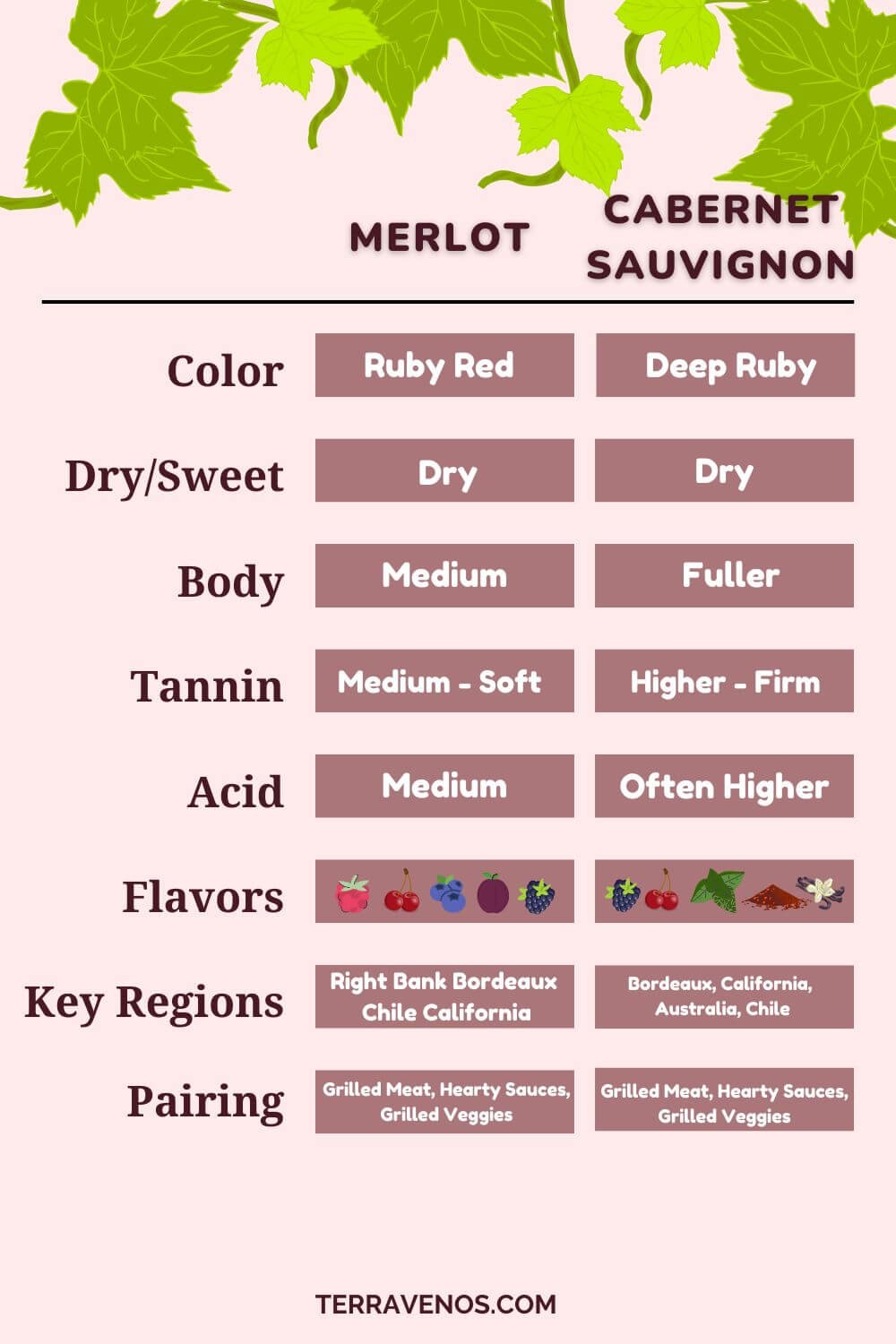
When it comes to red wines, two famous styles come up frequently: Cabernet Sauvignon and Merlot.
Cabernet Sauvignon offers a bold body with rich notes of blackcurrant and cassis, while Merlot presents a softer body, showcasing flavors of plum and black cherry. Both wines can be enjoyed within the $20-$30 USD range, but are made at all price points.
Here’s what you need to know about the differences between Merlot and Cab Sav.
- Cabernet Sauvignon Basics: A Regal Red Classic
- Merlot Basics: Approachable Elegance
- Wine Comparison: Cabernet Sauvignon vs. Merlot
- Cabernet Sauvignon vs. Merlot Winemaking
- Cabernet Sauvignon vs. Merlot: Food Pairings and Serving Temperature
- Which Is More Expensive, Cabernet Sauvignon vs. Merlot?
- Which Is Better, Cabernet Sauvignon or Merlot?
- Final Thoughts – Cabernet Sauvignon or Merlot?
Cabernet Sauvignon Basics: A Regal Red Classic
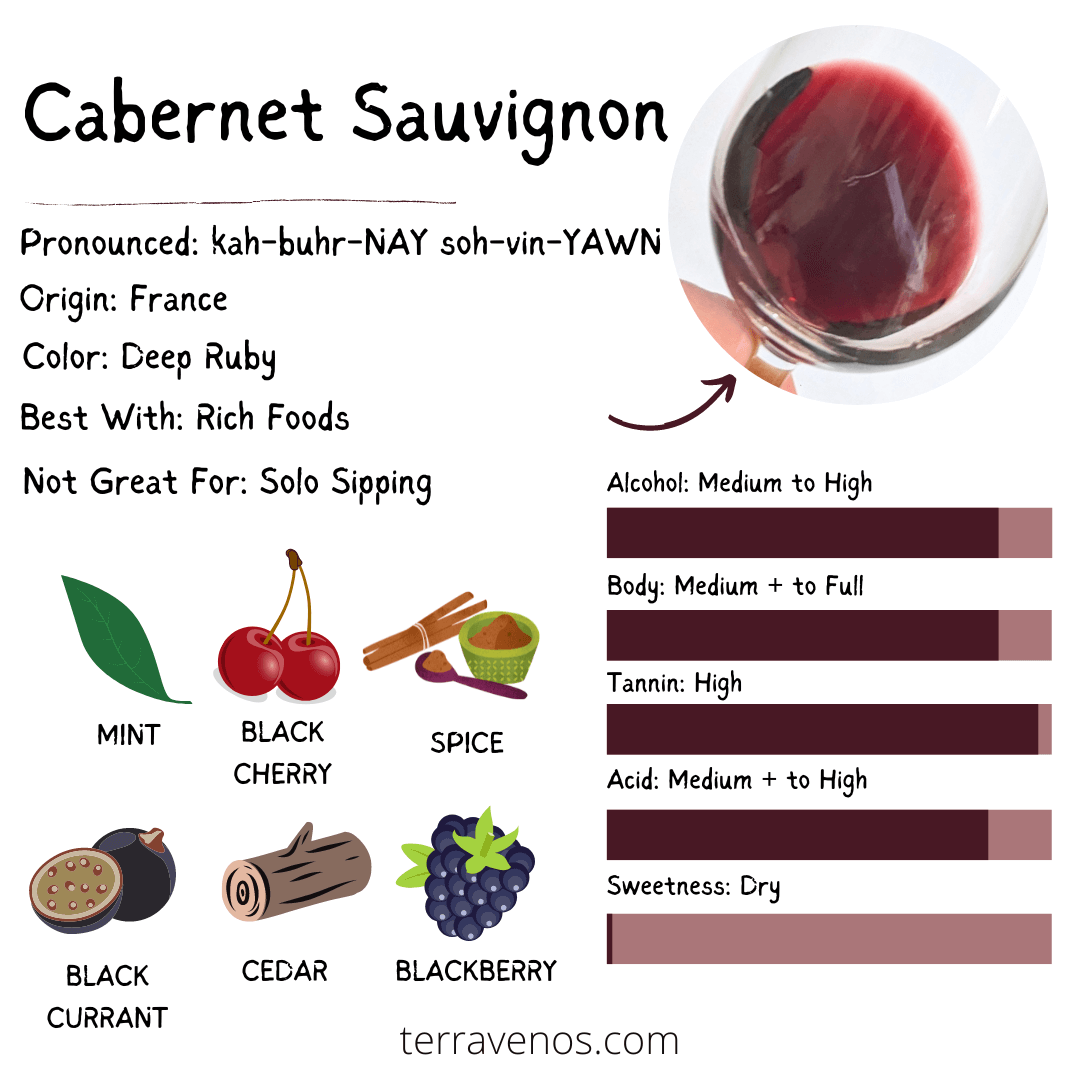
Originating from France, Cabernet Sauvignon has achieved global recognition for its strength and power. It’s associated with renowned winegrowing regions such as Bordeaux and Napa Valley.
Cabernet Sauvignon displays a full-bodied profile with robust flavors and aromas of dark fruits, such as blackberry and blackcurrant. Cab Sav has firm tannins, offering a structured and age-worthy wine.
Helpful Tip: Here’s a deep-dive into Cabernet Sauvignon wines.)
Planted widely, Cabernet Sauvignon is made at various price points, making it accessible for different budgets. From affordable everyday options to premium selections crafted by esteemed winemakers, the diversity of Cabernet Sauvignon ensures that you’ll find something for your glass.
Fun Wine Fact: Cabernet Sauvignon is often blended with other grape varieties, such as Merlot and Cabernet Franc, to create complex and balanced wines.
Merlot Basics: Approachable Elegance
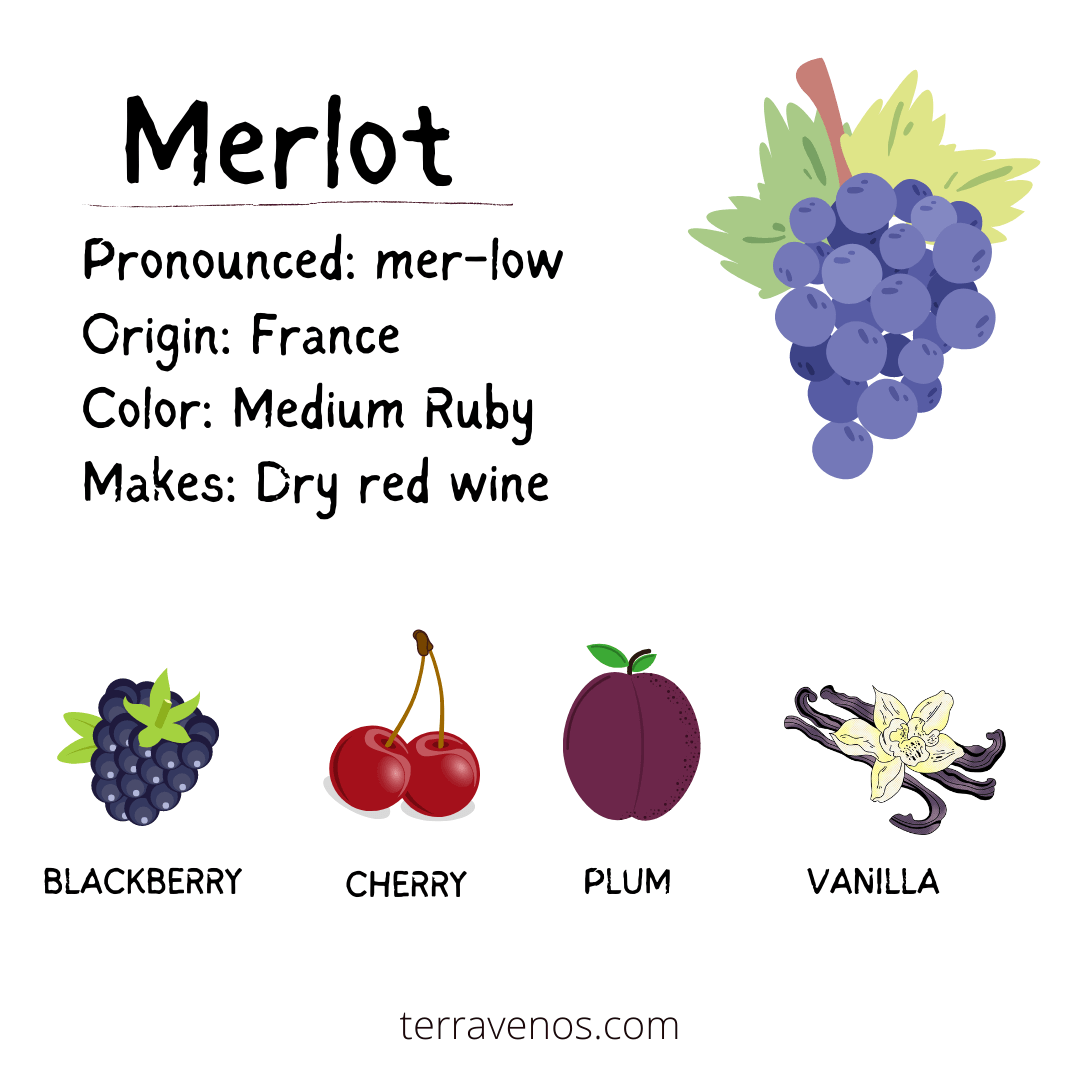
Merlot, a versatile and approachable red wine, has its origins in France as well and has gained popularity worldwide. Merlot’s known for its medium body and velvety texture, offering a smooth and supple drinking experience.
Merlot showcases flavors of ripe plums, black cherries, and sometimes hints of chocolate or herbs. Its softer tannins make it an excellent choice for those seeking a more approachable red wine.
Today, Merlot is cultivated in many wine regions globally, including California, Washington, and Chile. (Here’s a post on everything about Merlot wines if you’re curious for more.)
Wine Comparison: Cabernet Sauvignon vs. Merlot
Check out this side-by-side comparison of the most common characteristics of Cabernet Sauvignon and Merlot.
Cabernet Sauvignon Wine Profile:
- Sweetness: Cabernet Sauvignon is mostly made in a fully-dry style. Inexpensive Cabernets may be off-dry.
- Acid: Cabernet Sauvignon has medium plus to high acid, often higher than Merlot.
- Alcohol: Most Cabernet Sauvignon wines are are high alcohol, higher than Merlot.
- Body: Cabernet Sauvignon boasts a bold and full-bodied profile, offering a robust and intense drinking experience.
- Tannins: Known for its firm tannins, Cabernet Sauvignon provides a structured and age-worthy wine.
- Flavor and Aroma Intensity: Cabernet Sauvignon exhibits powerful flavors of blackcurrant, blackberry, and sometimes hints of cedar, tobacco, or vanilla.
- Flavors: The flavor profile often includes black fruits, dark chocolate, and herbal notes.
Merlot Wine Profile:
- Sweetness: Merlot wines are dry, like Cabernet Sauvignon, but may be off-dry if they’re cheap.
- Acid: Merlot wines have medium acid, lower than Cabernet Sauvignon.
- Alcohol: Most Merlots will have medium alcohol, lower than Cab Sav
- Body: Merlot showcases a softer and medium-bodied profile, offering a smooth and approachable drinking experience.
- Tannins: Merlot has milder tannins, providing a more supple and less astringent mouthfeel.
- Flavor and Aroma Intensity: Merlot presents flavors of ripe plums, black cherries, and occasionally hints of chocolate or herbs.
- Flavors: The flavor profile often includes ripe fruits, soft spices, and subtle earthy undertones.
Helpful Tip: If you’re still getting into red wines, here’s a 30-second tasting tip on how to taste tannins.
Are Cabernet Sauvignon and Merlot Similar?
Cabernet Sauvignon and Merlot share several qualities. Both wines offer rich flavors of dark fruits and can be paired with a variety of red meat dishes. If you appreciate Cabernet Sauvignon, you’re likely to enjoy the softer and more approachable nature of Merlot as well.
What Is the Difference Between Cabernet Sauvignon and Merlot?
The primary difference between Cabernet Sauvignon and Merlot lies in their body and tannin levels. Cabernet Sauvignon has a bold and full-bodied profile with firm tannins, while Merlot showcases a softer and medium-bodied nature with milder tannins. Cabernet Sauvignon tends to exhibit more intense flavors of blackcurrant and herbal notes, while Merlot offers ripe plum and black cherry flavors with a hint of chocolate or herbs.
Helpful Tip: If you’re new to red wine tasting, here’s a quick guide to help you taste different red wine styles.
Cabernet Sauvignon vs. Merlot Winemaking
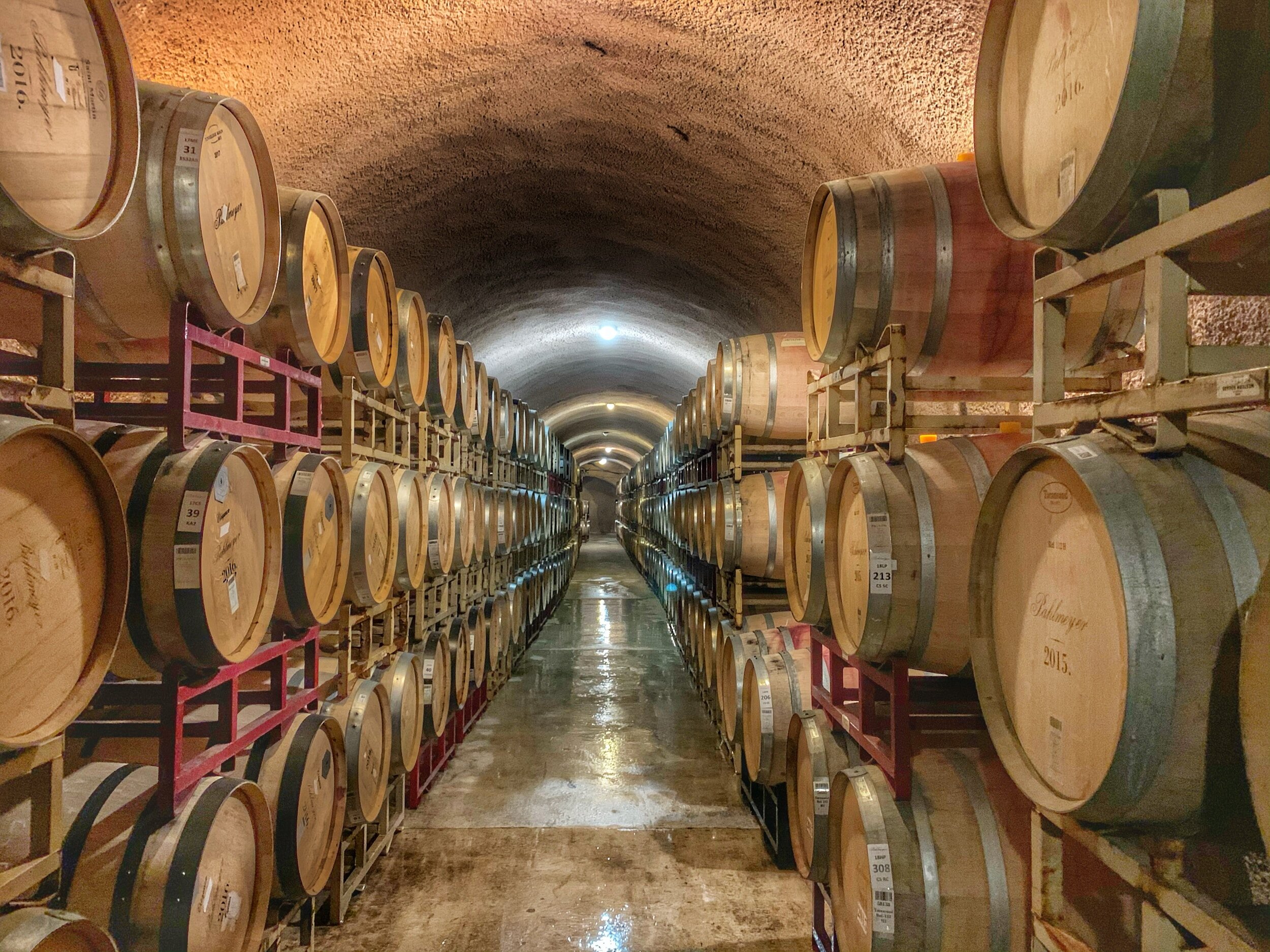
Both Cabernet Sauvignon and Merlot undergo similar winemaking processes. Stainless steel fermentation and oak aging are commonly employed to enhance the flavors and structure of the wines. Winemakers also experiment with various blending ratios and aging methods to create unique expressions of both Cabernet Sauvignon and Merlot.
Cabernet Sauvignon vs. Merlot: Food Pairings and Serving Temperature

- Cabernet Sauvignon’s bold flavors and firm structure make it an excellent companion for rich red meats, such as grilled steak or lamb.
- Merlot’s softer profile pairs well with roasted poultry, game meats, and dishes with tomato-based sauces.
Discover:
Cabernet Sauvignon Cheese Pairing Guide
Merlot Pairinng Guide
Cabernet Sauvignon and Merlot: Serving Temperature
| Cabernet Sauvignon | Merlot | |
|---|---|---|
| Serving Temperature | 60-65°F (15-18°C) | 60-65°F (15-18°C) |
| Decanting Time | 1-2 hours | 30 minutes to 1 hour |
Both Cabernet Sauvignon and Merlot are best enjoyed slightly below room temperature. Store the bottle in a cool place before serving.
Cabernet Sauvignon benefits from some aeration, so decanting it before serving can enhance its flavors.
Which Is More Expensive, Cabernet Sauvignon vs. Merlot?
Comparing the prices of Cabernet Sauvignon and Merlot, it’s natural to consider their relative costs.
Cabernet Sauvignon Wine Cost:
- Extreme value Cabernet Sauvignon wines are under $10 USD.
- Decent drinking Cabernet Sauvignon wines are often available within the $20 to $30 price range, offering good value for the quality they provide. These wines showcase the classic characteristics of Cabernet Sauvignon without breaking the bank.
- If you’re seeking premium Cabernet Sauvignon wines, there are higher-priced options available. These bottles, priced around $50 to $100 or higher, offer exceptional complexity and aging potential.
Merlot Wine Cost:
- Similar to Cabernet Sauvignon, decent drinking Merlot wines fall within a comparable price range of $20 to $30 per bottle. These wines provide a great introduction to the varietal, delivering approachable flavors and a smooth drinking experience.
- On the premium end, Merlot can be found at higher price points, ranging from $40 to $80 or more. These wines often come from prestigious vineyards and exhibit enhanced depth and complexity.
Helpful Tip: What’s a good Merlot wine price? Here’s what you should be paying for a bottle of Merlot depending on the drinking experience you’re looking for.
Which Is Better, Cabernet Sauvignon or Merlot?
If you prefer bold, full-bodied red wines with intense flavors and firm structure, Cabernet Sauvignon will be the better choice for you. If you dislike drying red wines and enjoy softer, medium-bodied, more approachable red wine, then Merlot is the better option.
Personal Note: If you’re just getting started with red wines, I think Merlot’s the better gateway wine and tends to be more approachable for new drinkers.
Final Thoughts – Cabernet Sauvignon or Merlot?
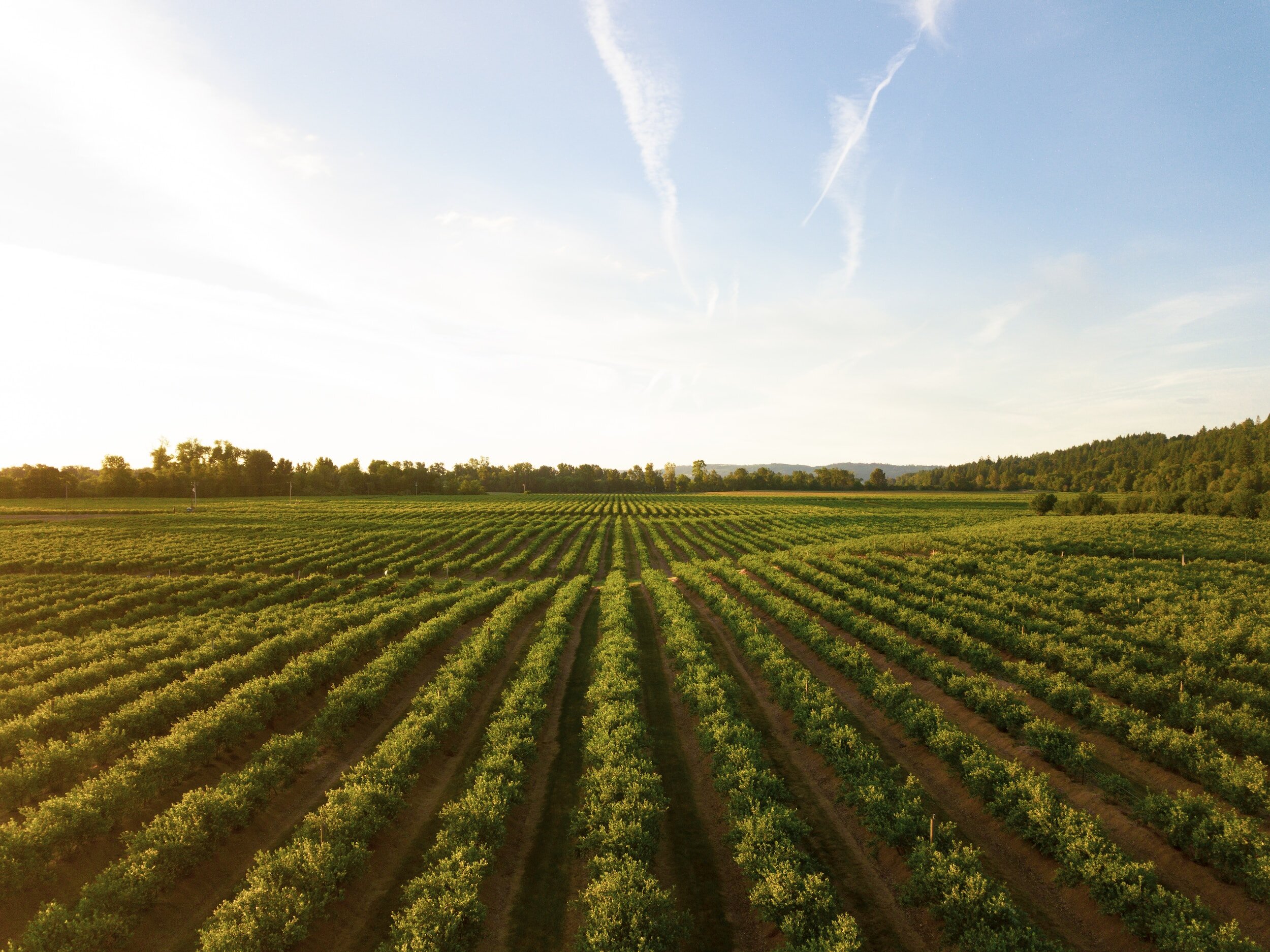
Both Cabernet Sauvignon and Merlot offer distinctive experiences for wine drinkers.
- Side-by-side tastings are a fantastic way to appreciate and understand the differences between these two wines.
- Go out and find two bottles of similarly priced Cabernet Sauvignon and Merlot, gather some friends, and pour yourselves some wine.
Cabernet Sauvignon impresses with its boldness and age-worthiness, while Merlot charms with its approachable elegance and smooth texture.
Discover More:
Cabernet Sauvignon vs Malbec
Cabernet Sauvignon vs Chardonnay
Cabernet Sauvignon or Pinot Noir?
Merlot vs Pinot Noir
Merlot vs Chardonnay
Merlot vs Malbec
Sangiovese vs Merlot
Merlot vs Pinot Grigio
Thirsty for More?
Hosting a wine tasting for beginners is one of the best ways to learn about wine. Here’s a guide on how to host a DIY wine tasting.
If you’re interested in exploring other popular red wines, check out this post on Cabernet Sauvignon vs Cabernet Franc.
Finding great wines within a specific budget can be exciting. Take a look at this post on how to discover excellent wines under $50.
For a fun read, dive into this post about the history and production of Rosé wines, a perfect choice for those who enjoy light pink wines!



